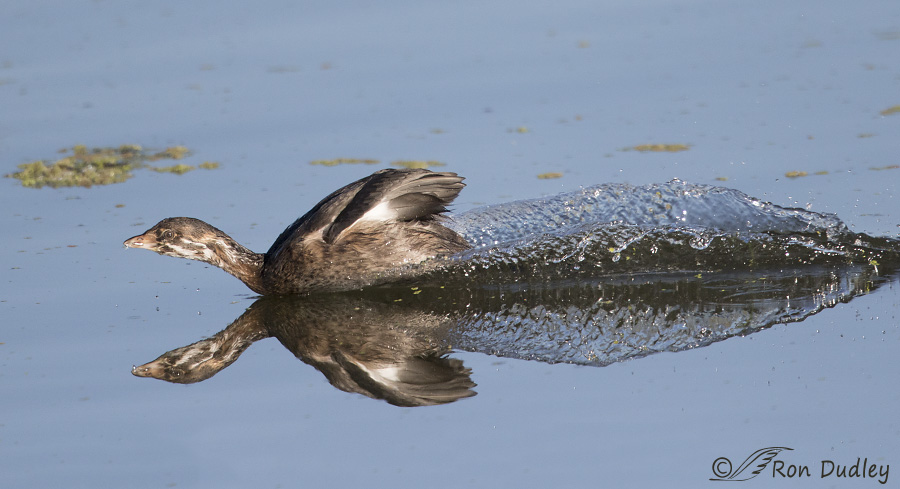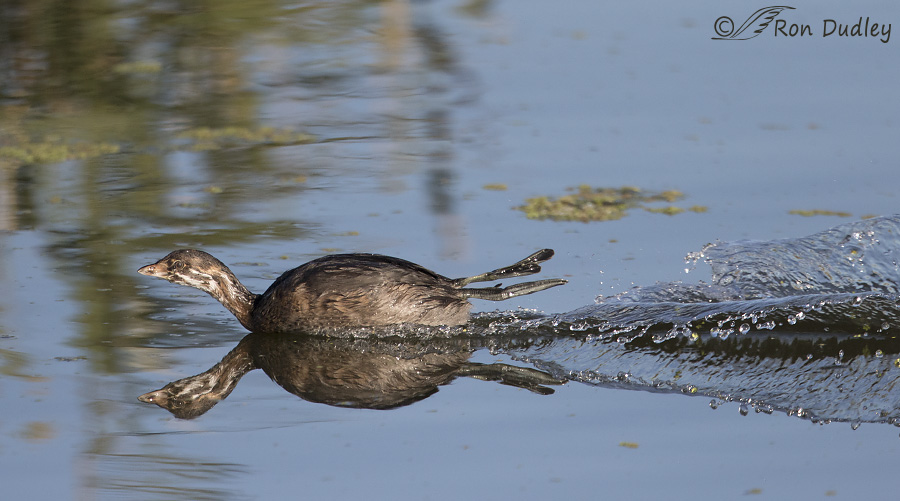Podiceps, the genus name for grebes, means “anus-foot”. Unlike some Latin names, this one is well-earned.
Grebes are unique to most other water birds in two ways: 1.) their legs are attached to their bodies at the rear (thus “anus-foot”), rather than underneath and 2.) the toes of grebes are lobed instead of webbed. Having legs attached at the rear allows for efficient swimming but causes extreme clumsiness while walking – they rarely venture on to land but when they do they often fall down after just a few steps. And recent experimental work with grebes has demonstrated that the lobes on the toes function much like the hydrofoil blades of a propeller. In other words, grebes are built for speed both on and in the water.
Yesterday morning at Farmington Bay WMA I photographed a juvenile Pied-billed Grebe demonstrating both its speed on the water and how it’s able to accomplish it.

1/5000, f/5.6, ISO 800, Canon 7D Mark II, Canon EF500mm f/4L IS II USM +1.4 tc, canvas added for composition, not baited, set up or called in
Though many folks ignore them I love photographing Pied-billed Grebes because their behavior is so mercurial. One moment they seem lethargic to the point of boredom and the next moment all hell breaks loose – usually in fighting as they try to steal fish from each other or scampering across the water for whatever reason. But they’re very fast and difficult to photograph well when they do it. When photographing them I usually have fast shutter speeds dialed in just in case I get lucky and yesterday I did.
I cropped this image as I did to emphasize the incredible trough this tiny bird carves into the surface of the water as it accelerates. It takes speed to do that and the next image in the sequence shows how they’re able to achieve it.

1/5000, f/5.6, ISO 800, Canon 7D Mark II, Canon EF500mm f/4L IS II USM +1.4 tc, not baited, set up or called in
Just look how far back and high on the body those legs are attached (visualize a walking duck for comparison). Since the leg attachment is usually hidden from view this may be one of my best shots of any grebe species to demonstrate the unusual attachment point. The “surfboard effect” has raised that plump little body high enough out of the water so the attachment point can be easily seen.
Birds of North America Online has a wonderful description of the mechanics of grebe swimming:
- “Feet placed far back; considerable ability to rotate tibiotarsus allows grebes to move feet above, below, or level with body underwater. Hence can steer on propulsive strokes. Grebe feet show special adaptations for propulsion; 90° rotation of foot between power and recovery strokes is different from any other family of living birds. Toes are connected by webs to base of second joint; distal ends have asymmetrical lobes. Function of smaller inner lobes and larger outer lobes is similar to that of inner and outer vanes of primaries, facilitating automatic rotation and thus reducing drag on return stroke.”
I love how descriptive Podiceps is of the grebes but I must admit that I’m having a hard time resisting a joke line or two with the phrase “anus-foot”, especially after watching some of the recent political debates.
But I’ll resist that temptation, at least for now…
Ron


What a cracking way to show the grebes feet, an amazing photo.
Very interesting shots. The second shot makes it look like the bottom half is upside down to the top half.
If only our politicians were as efficient or as beautiful…
But they aren’t. So I will continue to call them oxygen thieves.
Another fascinating (and beautiful) series.
Thank you, EC.
They take up space, use up oxygen, pollute our minds, destroy oir hopes and our dreams, and are a parastic waste of our limited, vital resources…otherwise they’re OK….
I guess I could add…They are not as colorful.
Very interesting photos! What I find most interesting about the first photo is that thanks to reflection, the shape of the wake matches the shape of the bird’s body. In the second one, the bird’s body looks to me rather like a balloon on water. I love these reflections; they rather remind me of a kaleidoscope…
Yeah, I’ve been paying more attention to reflections lately too, Susan. They can really enhance some photos.
Superb post! Information with illustrations! I could watch these little birds for hours – oh, wait – I do that already!
I can’t believe you would consider stooping to making a joke out of our serious political system whereby we select the most qualified — I’m sorry — I can’t continue this with a straight face.
“I could watch these little birds for hours – oh, wait – I do that already!”
And I did it once again this morning, Wally. I had lots of fun but I mostly screwed up more shots of them running on water. It’s not an easy shot to get. Thanks you.
Hi Ron, great photos! Love all the information. There is no disorder in the order of nature! And, I can announce someone a Grebes without them figuring out what I’m really inferring!
Deborah, thank you for a good laugh! I hope you don’t mind if my husband and I borrow your idea – I think we have frequent need of it in conversation…
Now there’s a creative way of making a jab, Deborah!
Great shots and very interesting info.
Charlotte
Thank you, Charlotte.
They always remind me of undersized (under-inflated?) footballs with high powered outboards…
Great analogy, Patty.
Like the current proliferation of political podiceps, whose ability to walk(or in this case, “run”) with their feet in their mouths amazes me, I wonder how these little marine footballs can walk…unless it’s upright, leaning backwards…
.
They can’t walk, Patty – not really. I’ve seen them try and they always fall down after a few “steps”.
Guess that means, sadly, if chased onto shore, they’re sitting ducks for some predator….
WOW! Almost like they need to be on their back to walk. Always amazed by the adaptations of different animals to function in their environment. The high shutter speed served you well stopping the motion and capturing the detail of the bird and water. I can also think of a line or two regarding the name and politicians.
I can also think of a line or two regarding the name and politicians. 
“I can also think of a line or two regarding the name and politicians.”
It’s hard to resist, isn’t it, Judy? Thank you.